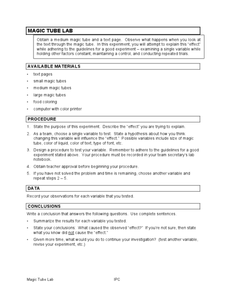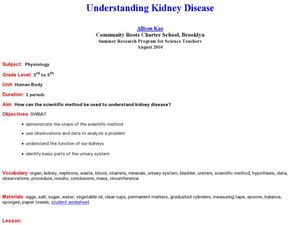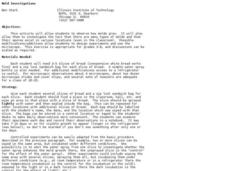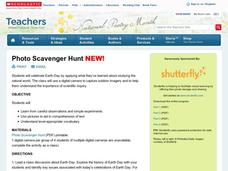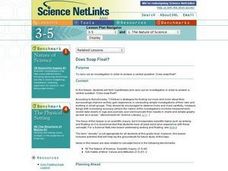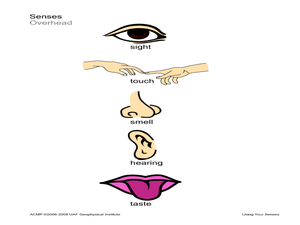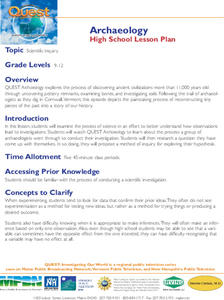Curated OER
The Egg Activity
High schoolers comprehend the three basic steps of science: 1) Observation, 2) Statements of cause and effect (Hypotheses), and 3) Testing. By working with an egg, students are required to observe an object that is very common to them. ...
Curated OER
Magnet Muscles
Students experiment with magnetism. In this science instructional activity, students are divided into cooperative learning groups and use the scientific method to test their hypothesis. Each group performs a different experiment.
Curated OER
Magic Tube Lab
In this scientific investigation learning exercise, students use "magic tubes" to make observations, hypothesize, study variables in experiments, write procedures, and draw conclusions.
Curated OER
Gas Laws and Alka-Seltzer Rockets
Students investigate the Ideal Gas Law. For this three states of matter lesson, students create Alka-Seltzer rockets using film canisters. Students record observations and data according to the scientific method and explain the gas...
Curated OER
Charles Darwin
Young scholars research Charles Darwin and the process he used to develop his theory of evolution. They keep a journal about the skill of observation and make a newspaper of their learning.
Curated OER
Polluting the Environment
Fourth graders construct mini-ecosystem, pollute the ecosystem, observe, collect, and record data on the effects of these pollutants on their ecosystem, organize data on spreadsheets, create graphs, and design presentations to share with...
Curated OER
Theories, Hypothesis, Laws, Facts & Beliefs
In this scientific statements worksheet, students are given 35 statements and they are to identify if each statement is a fact, law, hypothesis, theory or belief.
Curated OER
Understanding Kidney Disease
Students experiment to determine information about kidney function. In this kidney function lesson, students use the scientific method to experiment with eggs, water, salt, sugar, and vegetable oil to simulate kidney function. They...
Curated OER
Seed Sorting
Students examine and sort seeds. In this life science lesson, students make general observations of a tub of seeds, then develop sorting criteria for sorting the deeds. Lesson includes extension activities.
Curated OER
Mold Investigations
Students observe mold growth on bread. For this mold growth lesson, students place bread in various locations and in various conditions to investigate how location, moisture, temperature, and other variable impact the growth of mold on...
Curated OER
Look at those Leaves!
Students observe leaves for patterns and similarities. In this science instructional activity, students sort through a pile of leaves to find patterns and take measurements. Students make leaf rubbings to view the details of the leaves.
Curated OER
Mobius Strips
Students discuss the scientific method and construct their own Mobius Strips. They examine their Mobius Strip, and write observations and a hypothesis on how many strips of paper they have when they cut the strip in half length-wise.
Curated OER
Measuring Temperature
Students conduct an experiment using the steps of the scientific method. In this scientific method lesson plan, students experiment with temperature and record their findings using the scientific method. Students complete a data sheet...
Curated OER
The Behavior of Ants
Students use the steps of the Scientific Method to develop and test their own ideas through experimentation with ants.
Curated OER
Non-Compressibility of Water
Students will observe a property of water. For this inquiry-based properties of air lesson, students observe how a change in water pressure impacts the positioning of an eye-dropper in the water container and they make hypotheses about...
Curated OER
Photo Scavenger Hunt
Students celebrate Earth Day by applying what they've learned about studying the natural world. In this Photo Scavenger Hunt lesson plan, students use a digital camera to capture outdoor imagery and to help them understand the...
Curated OER
Diffusion of Molecules
Students conduct a series of experiments to observe factors that impact molecular movement. In this molecular chemistry instructional activity, students drop food coloring in water with different properties (hot, with ice, with alcohol)...
Curated OER
Identifying an Earthworm
Learners navigate the Internet to learn to identify Earthworms. In this taxonomy instructional activity, students explore species of earthworms finding their characteristics and using photographs to identify the species. Learners...
Curated OER
Does Soap Float?
Students form hypotheses and carry out an investigation in order to answer a central question: Does soap float? The focus of this lesson is on scientific inquiry, but it incorporates scientific topics such as sinking and floating.
Curated OER
Basics of Science
In this basics of science worksheet, students review the metric system, the difference between homogenous and heterogenous mixtures, the scientific method, and science lab first aid. This worksheet has 15 short answer, 43 fill in the...
Curated OER
Classification of Cerealites
Students create a dichotomous key. In this categorizing lesson, students create a dichotomous key for different types of cereal. Students classify the cereal into groups such as flakes and cereal with holes. Students discuss their...
Curated OER
Sucker Science Lesson
Fourth graders follow the scientific lesson to investigate flavor. In this scientific method lesson, 4th graders conduct a flavor test with mislabeled Tootsie Pops. Students record their experiment.
Curated OER
Using Your Senses
Students make observations. In this sensory skills instructional activity, students use their senses as well as tools that sharpen their senses to make observations regarding foods and other items.
Curated OER
Archaeology
High schoolers examine how observations lead to investigations, and how archaeologists conduct their investigation.




